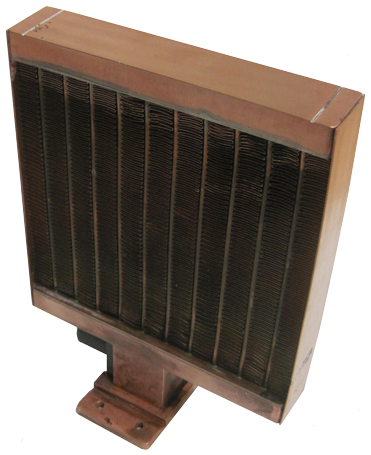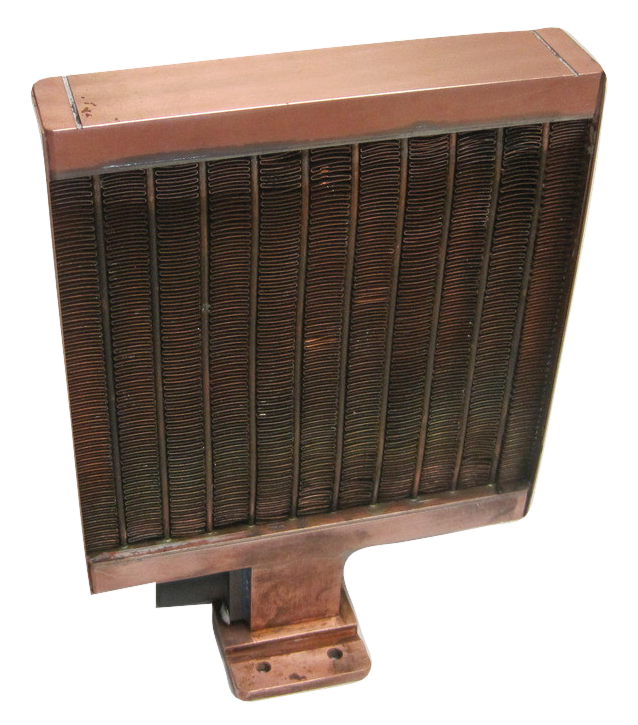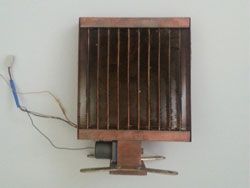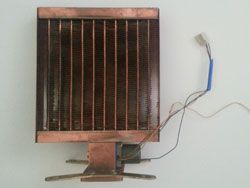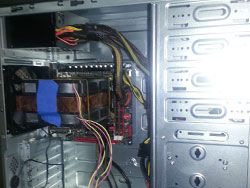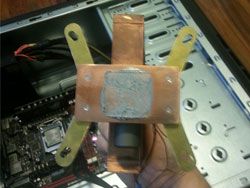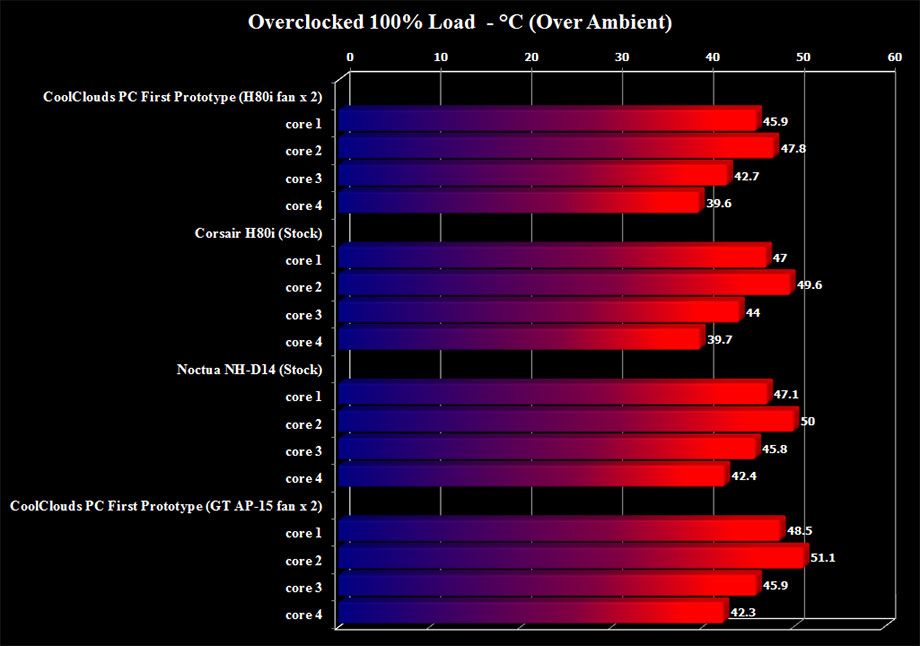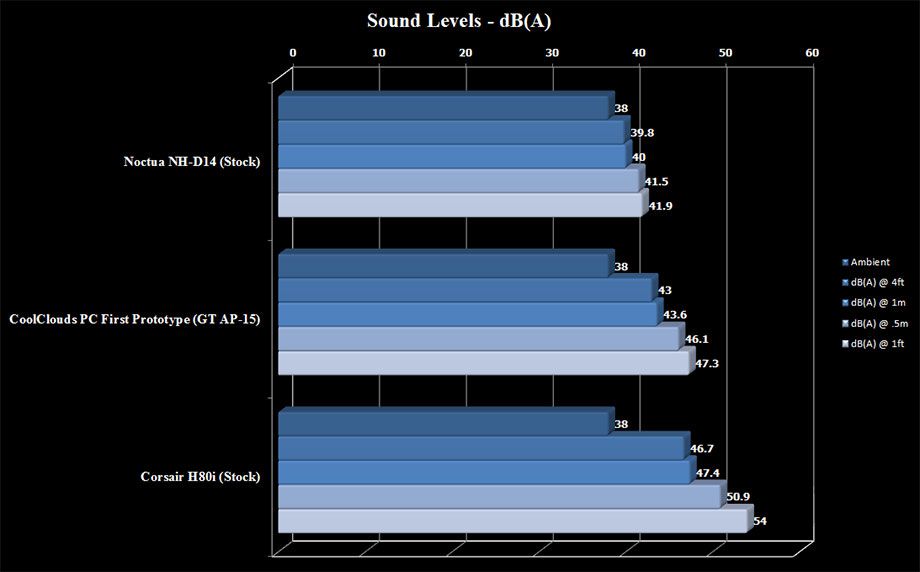TheHobbyist
Hugs Hard Johnnies [H]ard
- Joined
- Apr 8, 2008
- Messages
- 456
Introduction
Hello everyone, and thank you for stopping by! Recently, I had a very unique and exciting opportunity present itself. Today, I would like to share the details of the experience with my fellow enthusiasts!
Living in northern California comes with many perks (like amazing weather), but one of my favorites is that many tech companies call it home! As a result, I've had the privilege of visiting the offices of some amazing tech companies like Intel, AMD, Nvidia, ASUS, Antec, etc. In addition to the large and established tech companies, many hungry tech start ups can be found here as well.
By chance, I noticed that a tech start up by the name of CoolClouds was looking for a computer hardware enthusiast in the northern California area. They had developed an early prototype of a CPU cooler that incorporated the technology and techniques they had been using in their business cooling products. CoolClouds explained that their typical business involved designing custom cooling solutions for companies for electronics such as servers, telecommunication devices, and military equipment applications. They were not very familiar with the aftermarket CPU cooling environment and were looking for feedback.
Fast forward a short while and I found myself with an early CoolClouds CPU Cooler Prototype in my hands, hot off the production line! CoolClouds was generous enough to give me hands-on experience with their prototype and allow me to run a slew of enthusiast inspired tests on it. Below, you will find the results!
System Setup
Test Bed:
- Motherboard: ASUS Maximus VI Impact
- CPU: Intel Core i7 4770k
- Memory: 8 GB (2x4GB) Samsung DDR3 1600 "Magic Ram"
- Video: Integrated
- Hard Drive: Samsung 840 Pro 256GB SSD
- OS: Windows 8.1 64 Bit
- Thermal Paste: Noctua NT-H1
Test Methods
- CPU: CPU temperature will be monitored in windows using AIDA64 Extreme Version 4.30.2900
- GPU: The integrated GPU in the Intel i7 4770k will be used, eliminating the heat of the discrete GPU as a variable.
- CASE: The case used for this first round of testing is the Antec VSK-4000E Mid Tower Case
- Thermal Paste: Noctua's NT-H1 thermal paste was used for a few key reasons: It's well known in the community for its performance and for not having an observable curing time, and I had a large syringe of it already =)
- Temperatures:
- Ambient: Ambient temperature will be measured throughout the test using an Exergen Infrared Thermometer. If there is any change in ambient temperature greater than .5C during the course of the test, the test will be restarted.
- Idle: Idle temperature will be recorded after a 25 minute period of inactivity.
- Load: Load temperature will be recorded following a 20 minute period of 100% load for air coolers and after a 30 minute period of 100% load for air/water hybrid coolers. The load will be obtained by running the AIDA64 Extreme Version 4.30.2900 System Stability Test. The values reported will represent the average temperature during the load testing period.
- Sound: Sound levels will be measured with a Sinometer JTS-1357 Digital Sound Level Meter. A measurement will be taken at a distance of 1ft, .5m, 1m, and 4 ft. In each instance, the ambient sound level of the room will be recorded.
CoolClouds CPU Cooler Prototype
The CoolClouds CPU Cooler Prototype has a lot of familiar features to other coolers I have worked with in the past, at first glance. However, after taking it all in, it is clear that it is definitely something new, and something cool. On the one hand, I can see that it has a copper plate for contact with the CPU and I can see that the entire unit is designed to mount directly to the motherboard. But on the other hand, I see a 120mm radiator and what looks to be to be none-other than a water pump like the ones I have used in custom water cooling loops! Missing, however, are the tubes typically involved in a hybrid cooler setup. Also, the all-copper nature of the cooler is simply something to behold.
In addition to having full access to the prototype, the CoolClouds crew also made themselves available for any of my questions or other needs. They quickly brought me up to speed on the CoolClouds technology set that includes custom-designed and optimized micro-channel cold plates, powerful, miniaturized water pumps, and fine-tuned all copper radiators. With this technology set, CoolClouds has been morphing into some of the most challenging design spaces and has shown time and time again that they can provide greater cooling performance than any other current solution on the market.
In speaking with the CoolClouds team, it is clear that they are very confident in their designs and their technology. I think it was very bold of them to reach out directly to the enthusiasts and to allow one of them to pit their first prototype against the competition. Lets find out if their confidence and enthusiasm are backed up by performance, shall we? =)
Specifications
- Cooler Dimensions: 165 mm x 120 mm x 16 mm
- Weight: 900g
- Fin Material: Copper
- Cold Plate Material: Copper
- Compatibility: All Modern CPU Sockets
- Fan: Nidec-Servo Gentle Typhoon (x2)
- Size: 120 mm x 25 mm
- Speed: 800-1850 rpm
- Air Flow: 58 CFM
- Noise: 26 dB
Having designed and built computers for over 15 years, I have seen a lot of CPU coolers and their specs. What stands out to me looking at these specs is that the radiator itself is only 16mm thick. I am interested to see how this factors into performance. Additionally, I am very excited to see both copper cold plate and copper radiator! Most, if not all, of the AIO hybrid coolers out on the market use aluminum radiators. This has the effect of reducing thermal performance. Also, since the system has a mix of copper and aluminum, they are forced to use fluids other than pure, distilled water. This also has the effect of reducing thermal performance. It will be interesting to see if the all-copper construction can counter-balance the reduced thickness of the radiator.
Photos:
Here are some shots of the front, back, and base of the prototype:
Installation and Contact:
Being a prototype, no installation manual was provided. I've installed quite a fair number of heatsinks, but honestly, the installation of the prototype was extremely straightforward and did not require much mechanical ability. First, I placed the provided backplate on the rear of the motherboard, lining it up with the socket holes. Second, I hand-tightened 4 standoffs into the backplate from the other side of the motherboard. Third, I placed the appropriate amount of thermal paste on the center of the processor heatspreader. Fourth, I placed the prototype (without fans installed) on the processor. Fifth, I installed the provided screw/spring assemblies through the four bracket holes and into the previously installed standoffs. There were absolutely no obstructions or tight spots preventing me from easily tightening the screws. As always, I took my time tightening the 4 screws moving in an "X" pattern to ensure even pressure across the CPU. I then attached the two Gentle Typhoon fans and connected the pump and the 2 fans to the appropriate motherboard headers.
After the performance testing was complete, I removed the prototype and verified that I had solid contact between the cooler and the processor. As you can see in the image, good contact was present.
With all of that out of the way, lets take a look at how it performed!
Performance Results:
Results: Temperatures
For stock testing, my Intel Core i7 4770k will be set at 3.50 GHz and 1.05 volts. For overclocked CPU testing, my CPU will be set at 4.4 GHz and 1.20 volts.
Please note that the performance chart represents degrees Celsius over the ambient temperature at the time of testing. The temperatures listed DO NOT represent direct core temperatures.
Overclock Settings
With the Intel Core i7 4770k set at 4.4 GHz and 1.20 volts, we present a worthy challenge to the established kings of the CPU cooling realm as well as to the new challenger. Claiming the top performance spot with a 1 degree Celsius lead is the CoolClouds Prototype equipped with the two fans from the Corsair H80i cooler! To me, this is fairly remarkable; the CoolClouds Prototype radiator is only 16mm thick vs the Corsair H80i radiator which is a very stout 38mm thick. In an apples to apples performance shootout with the same testbed and and same fan configuration, the CoolClouds Prototype is able to best the Corsair H80i with less than half the radiator thickness! I found this a little hard to believe, so I ran the test 3 times on both coolers to verify the results.
Coming in second and third place in thermal performance in the overclocked testing were the Corsair H80i and the Noctua NH-D14 respectively. I was fairly impressed with the Noctua NH-D14 air cooler's ability to compete with the Corsair H80i All In One water cooler. The Noctua NH-D14 is significantly larger though. One important note that I will make is that the Noctua NH-D14 is able to provide it's 3rd place cooling performance at a much quieter level than the Corsair H80i as you will see in the coming sound performance evaluation.
Being a long time enthusiast and custom loop water cooler, I wanted to see how the CoolClouds Prototype performed with the long-running champion of performance/noise radiator cooling fans (The Gentle Typhoon AP-15). If you have never had the privilege of using a Gentle Typhoon, they provide an astounding amount of cooling performance on radiators, but at a noise level that is much less than the competition. Looking at the chart, we can see that the CoolClouds Prototype equipped with a pair of GT AP-15, with its diminutive 16mm radiator, performed within 2 degrees Celsius of the Corsair H80i and the Noctua NH-D14.
The Noctua NH-D14 represents best in class performance in the air cooler category according to many enthusiasts and performance reviews alike. Likewise, the Corsair H80i represents best in class performance in the 120mm AIO cooler category. In spite of this, The CoolClouds Prototype came out swinging and demonstrated that even in such an early stage of development, it was ready to take on all challengers and bring new levels of performance and a new CPU cooler form factor to the enthusiast cooler market.
Results: Sound
Please note that the sound performance chart represents measurements from 4ft, 1m, .5m, and 1ft. All measurements were taken with the case door removed and with the decibel meter aimed directly at the CPU cooler being measured.
As I alluded to earlier in the performance testing commentary, the Corsair H80i is much louder than the Noctua NH-D14 with the fans at 12v. The measurements verify this claim as can been seen in the chart.
Subjectively, I found both the Noctua NH-D14 and the CoolClouds Prototype equipped with the Gentle Typhoons to provide a very similar acoustic profile with the sound of the air flowing through the coolers barely perceivable. On the other hand, I found the acoustic profile of the Corsair H80i to be quite loud and disruptive. It definitely made a lot of noise. In the case of the Corsair H80i, it's performance comes at the cost of a quiet computing experience.
Conclusion
The Bottom Line
First of all, I would like to thank the fine folks at CoolClouds for the opportunity to work hands-on with their first prototype and for their open-door policy regarding any questions or comments that I had throughout the experience. It is clear that they are very busy, but that they take the quality of their product and their customer's experience as the highest priority.
Early on, I had concerns that the 16mm radiator would prove too thin to provide adequate performance. As it turned out, The 16mm all-copper radiator of the CoolClouds prototype proved superior to the 38mm aluminum radiator of the Corsair H80i. As a matter of fact, the slim 16mm CoolClouds Radiator was able to provide superior performance over the gargantuan 100mm thickness of fin tower used by the Noctua NH-D14! How embarrassing!
I would also like to take a moment to talk about the form factor. In the testbed, I utilized the small but mighty ASUS ROG Maximus VI Impact. The Impact is an mITX board. In the case of the Noctua NH-D14, the cooler literally consumed the entire motherboard! I will provide images, but they simply don't do the situation justice. I appreciate the fact that the Noctua NH-D14 mounts directly to the motherboard and does not require the sacrifice of a case fan, but the cooler is just insanely massive! In the case of the Corsair H80i, the installed size was more manageable, but I was forced to sacrifice the rear exhaust of my case. This is a problem for me. In most of the systems I have built in recent years, the discrete graphics cards are by far the greatest producers of heat. For this reason, it is paramount to me that the case airflow is able to function as it was designed to aid in cooling passive motherboard components and removing the excess heat generated by the GPU(s). In the case of the CoolClouds Prototype, it mounted directly to the motherboard and installation was done! I was also able to maintain the use of my case exhaust AND I had plenty of room to work with, no special tools required.
The CoolClouds CPU Cooler Prototype, for me, was like glancing into the future of electronics cooling. It made a very big impression on me. When I look at air coolers, I see a cooling technology that has reached the limits of its performance. When I look at AIO coolers, I see case airflow design thrown out the window, and I see GPU's and CPU's fighting over case exhaust and inlet locations. When I look at the CoolClouds prototype, I see a smaller cooler with better performance! I see a cooler without compatibility issues that allows anyone to do a drop-in-replacement and explore the boundaries of their CPU's performance without thermal limitations. I see a cooling technology that can let Intel and AMD know that they can go ahead and raise the TDP (Thermal Design Power) of their desktop processors, because a new standard of cooling is in place to handle it. I look forward to seeing CoolClouds consumer products, and I think you probably would too!
The Future
During my time working with the CoolClouds team and the prototype, there was a constant line of communication. They had a lot of questions about the heat problems computer enthusiasts run into and the pro's and con's of the different solutions out there. To me, it seems that the team could never be happier than to be presented with a challenging heat problem that they can devour and design and engineer a powerful solution to. We had a lot of discussions and I gave a lot of feedback. They asked what I wanted to see, and this is what I told them:
- Cooler
- Quieter
- Compatible
You can find out more about CoolClouds @ http://www.coolclouds.net/
DISCUSSION:
What do you think? Got any questions for me or the CoolClouds team? Let me know! Is there anything else you would like to see for the enthusiast prototype testing? If it's something I can do, I'll give it a go as time allows!
Thanks! Hope you enjoyed!
TheHobbyist
Thanks! Hope you enjoyed!
TheHobbyist
Last edited:
![[H]ard|Forum](/styles/hardforum/xenforo/logo_dark.png)
